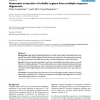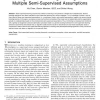71 search results - page 8 / 15 » Comparisons of sequence labeling algorithms and extensions |
BMCBI
2008
13 years 8 months ago
2008
Background: Prediction of disulfide bridges from protein sequences is useful for characterizing structural and functional properties of proteins. Several methods based on differen...
IISWC
2006
IEEE
14 years 2 months ago
2006
IEEE
— Recent advances in molecular biology have led to a continued growth in the biological information generated by the scientific community. Additionally, this area has become a m...
BMCBI
2007
13 years 8 months ago
2007
Background: High quality multiple alignments are crucial in the transfer of annotation from one genome to another. Multiple alignment methods strive to achieve ever increasing lev...
PAMI
2011
13 years 3 months ago
2011
—Semi-supervised learning concerns the problem of learning in the presence of labeled and unlabeled data. Several boosting algorithms have been extended to semi-supervised learni...
GECCO
2003
Springer
14 years 1 months ago
2003
Springer
The process of labeling each word in a sentence with one of its lexical categories (noun, verb, etc) is called tagging and is a key step in parsing and many other language processi...


